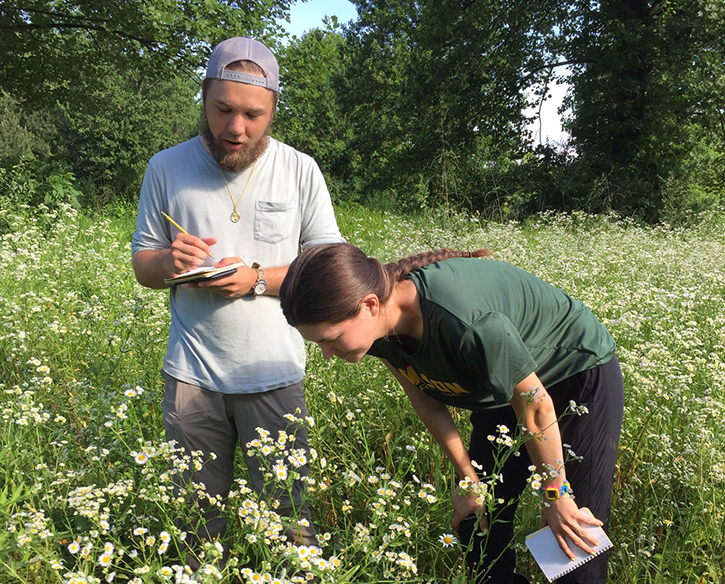
Junior environmental and sustainability studies major Ben Rhoades and senior environmental science major Elizabeth Rush were two of six students studying techniques of turning agricultural fields into native ecosystems. Photo provided.
How about this as a way to spend a summer afternoon?
“You’re hot, you’re sweating, but you don’t want to wipe your face because you have poison ivy.”
That is how senior Allison Rutledge described the worst day of a 10-week summer research project in which six George Mason University students studied various techniques of turning agricultural fields into native ecosystems.
Because the students spent so much time in the field, getting poison ivy was pretty much unavoidable.
Ultimately, though, “this project has gotten me more excited about field ecology,” said Rutledge, an integrative studies major with a concentration in applied global conservation. “You were able to see what it takes to start an experiment almost from the beginning. We developed hypotheses and analyzed data.”
In short, said Ben Rhoades, a junior majoring in environmental and sustainability studies and an Honors College member, “we became better scientists.”
The project was supported by a Summer Impact Grant through Mason’s Office of Student Scholarship, Creative Activities and Research.
Supervised by Joris van der Ham, assistant professor of environmental science and policy in the College of Science, and Tom Wood, associate professor in the School of Integrative Studies, the students studied four fields (three near The Plains, Virginia, and one near Warrenton, Virginia) that were restored during the past five years.
The students—also including seniors Elizabeth Rush and Marcy Delos (environmental science), sophomore Honors College member Cristian Ramirez (environmental and sustainability studies) and now-alumna Vanessa Hormann, BS Environmental and Sustainability Studies ’18—were split into teams of two. They captured and identified more than 14,000 insects, learned bird calls to identify birds populating a specific area and evaluated the abundance of plant life.
For six of the 10 weeks, they were in the field four days a week, from 7 a.m. to 3 p.m. But research also happened in labs, where insects received up-close-and-personal scrutiny, and plants were examined for their structural complexity.
.bottom.jpg)
Senior integrative studies major Allison Rutledge rests after a long day in the field. Photo provided.
“I love being in the field, but I was surprised I enjoyed the lab aspect of it,” Rutledge said. “It feels like you are privy to information that so many people don’t get to see. You do all this hard work in the field, and then you get to see it laid out in front of you.”
“Experimental design was one of the biggest takeaways for me,” Rhoades said. “As a student, you do experiments in your lab courses, but it’s not until you create an experiment on your own that you learn how to visualize what your end result data is in terms of creating your hypothesis.”
Data was correlated with the technique used to restore the field, including burning, spraying and plowing to get rid of grasses that cattle had been grazing on, and seeding to encourage plant growth.
What the students found, van der Ham said, was that the fields treated less intensely, generally, had ecosystems that were healthier and more complex.
More important than the outcome was the students’ experience, van der Ham said.
“It’s the application of the scientific method,” he said. “Many of these students have ideas about what is good and bad for nature and society. I hope that projects like this allow them to approach those ideas objectively and from a scientific point of view rather than saying, ‘Well, restoration techniques are good; the more the better.’ That opinion is fine, but how did you come to that conclusion?”
